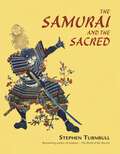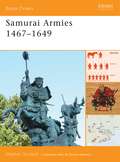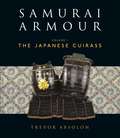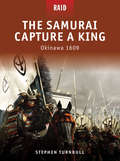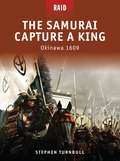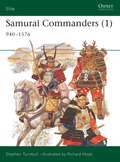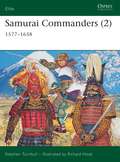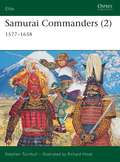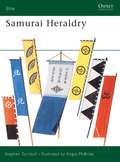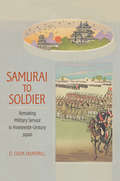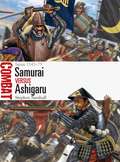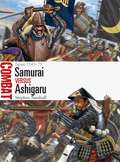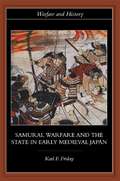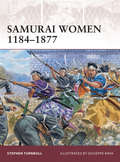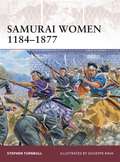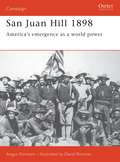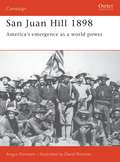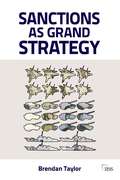- Table View
- List View
The Samurai and the Sacred: The Path of the Warrior (General Military Ser.)
by Stephen TurnbullThe fierce loyalty and self-sacrificing attitude of the Samurai have made them both a legend and a cult. Yet although their military prowess and skills in the martial arts have been studied exhaustively, an understanding of their belief system still eludes many. This original and exciting work examines the spiritual world of the samurai, from their attachment to Japan's mainstream religions of Shinto and Buddhism, to their involvement in Confucianism, Christianity and folk religion. Samurai expert Stephen Turnbull examines important topics such as Zen and the martial arts, modern militarism, the cult of the sword, revenge and suicide, hara kiri and the kamikaze pilots the suicide bombers of their day. He also looks at the fascinating issue of Japanese religious terrorism, as well as the growing cult status of the Samurai both in Japan and in the West.
The Samurai and the Sacred: The Path of the Warrior
by Stephen TurnbullThe fierce loyalty and self-sacrificing attitude of the Samurai have made them both a legend and a cult. Yet although their military prowess and skills in the martial arts have been studied exhaustively, an understanding of their belief system still eludes many. This original and exciting work examines the spiritual world of the samurai, from their attachment to Japan's mainstream religions of Shinto and Buddhism, to their involvement in Confucianism, Christianity and folk religion. Samurai expert Stephen Turnbull examines important topics such as Zen and the martial arts, modern militarism, the cult of the sword, revenge and suicide, hara kiri and the kamikaze pilots the suicide bombers of their day. He also looks at the fascinating issue of Japanese religious terrorism, as well as the growing cult status of the Samurai both in Japan and in the West.
Samurai Armies 1467–1649 (Battle Orders)
by Stephen TurnbullThe Sengoku The Jidai, 'Age of Warring States', is the age of the samurai the military aristocracy of Japan. This period, which lasted from the outbreak of the Onin War in 1467 to the establishment of the Tokugawa Shogunate in the early 17th century, was a period of endemic warfare, when a lack of central control led to constant struggles between the daimyo, 'great names', who sought to extend the influence of their families through political and military means. This title will examine the complicated nature of family and clan that governed so much of the initial organization of the armies, how this changed over the period and how battlefield tactics developed over a series of major encounters such as Nagashino and Sekigahara.
Samurai Armour: Volume I: The Japanese Cuirass
by Trevor AbsolonFor beauty, precision and strength, nothing has ever matched the combination of form and function found in the armour of the samurai. For a samurai, the consummate warrior, his suit of armour was so much more than 'just' protective equipment that could save his life in the heat of battle – it was the embodiment of his personality, social status and very soul. This volume, the first in a two-part series on the armour of the samurai, traces first the history of the samurai themselves and then examines the history and evolution of the cuirass or dou, the armour protecting the samurai's chest. Drawing on over 20 years of research and technical work by Trevor Absolon, a leading expert, this is a complete study of this fundamental aspect of samurai armour construction. Illustrated throughout with photographs and diagrams, this is more than just a detailed technical exploration, it is a meditation on a process that was, and still is, nothing short of an art form.
Samurai Armour: Volume I: The Japanese Cuirass
by Trevor AbsolonFor beauty, precision and strength, nothing has ever matched the combination of form and function found in the armour of the samurai. For a samurai, the consummate warrior, his suit of armour was so much more than 'just' protective equipment that could save his life in the heat of battle – it was the embodiment of his personality, social status and very soul. This volume, the first in a two-part series on the armour of the samurai, traces first the history of the samurai themselves and then examines the history and evolution of the cuirass or dou, the armour protecting the samurai's chest. Drawing on over 20 years of research and technical work by Trevor Absolon, a leading expert, this is a complete study of this fundamental aspect of samurai armour construction. Illustrated throughout with photographs and diagrams, this is more than just a detailed technical exploration, it is a meditation on a process that was, and still is, nothing short of an art form.
The Samurai Capture a King: Okinawa 1609 (Raid #6)
by Stephen TurnbullA brilliant but little-known operation, the Shimazu clan raid on the independent kingdom of Ryukyu (modern Okinawa) in 1609 is one of the most extraordinary episodes in samurai history and the culmination of centuries of rivalry between the two powers. The defeat of the Shimazu at Sekigahara in 1600, and their need to win favour with the new Shogun, led them to hatch an audacious plot to attack the islands on the Shogun's behalf and bring back the king of Ryukyu as a hostage. Stephen Turnbull gives a blow-by-blow account of the operation, from the daring Shimazu amphibious landing, to their rapid advance overland, and the tactical feigned retreat that saw the Shimazu defeat the Okinawan army and kidnap their king in spectacular fashion. With a detailed background and specially commissioned artwork, the scene is set for a dramatic retelling of this fascinating raid.
The Samurai Capture a King: Okinawa 1609 (Raid)
by Stephen Turnbull Richard Hook Donato SpedaliereA brilliant but little-known operation, the Shimazu clan raid on the independent kingdom of Ryukyu (modern Okinawa) in 1609 is one of the most extraordinary episodes in samurai history and the culmination of centuries of rivalry between the two powers. The defeat of the Shimazu at Sekigahara in 1600, and their need to win favour with the new Shogun, led them to hatch an audacious plot to attack the islands on the Shogun's behalf and bring back the king of Ryukyu as a hostage. Stephen Turnbull gives a blow-by-blow account of the operation, from the daring Shimazu amphibious landing, to their rapid advance overland, and the tactical feigned retreat that saw the Shimazu defeat the Okinawan army and kidnap their king in spectacular fashion. With a detailed background and specially commissioned artwork, the scene is set for a dramatic retelling of this fascinating raid.
Samurai Commanders: 940–1576 (Elite #125)
by Stephen TurnbullThe samurai were the military elite of medieval and early modern Japan, and the men who led them were hailed as the very greatest, most heroic and most honourable of all samurai warriors. This first of two books examines the lives, equipment, battles and wider roles of the samurai commanders between 940 and 1576, the period from the emergence of the samurai to the triumph of Oda Nobunaga, who set Japan on the road to reunification. The styles of armour and weaponry of the samurai changed considerably during this time and this book visually recreates some of the most famous samurai commanders.
Samurai Commanders: 940–1576 (Elite)
by Stephen Turnbull Richard HookThe samurai were the military elite of medieval and early modern Japan, and the men who led them were hailed as the very greatest, most heroic and most honourable of all samurai warriors. This first of two books examines the lives, equipment, battles and wider roles of the samurai commanders between 940 and 1576, the period from the emergence of the samurai to the triumph of Oda Nobunaga, who set Japan on the road to reunification. The styles of armour and weaponry of the samurai changed considerably during this time and this book visually recreates some of the most famous samurai commanders.
Samurai Commanders: 1577–1638 (Elite #128)
by Stephen Turnbull Richard HookThis second volume about Japan's samurai commanders covers the generals of the later years of the Age of the Warring States, a period when only the most able leaders survived. This was a time when the prowess of a commander was measured as much by his strategic and organizational abilities as by his individual fighting skills and he was expected to give as great a show of strength in the council chamber as on the battlefield. This book discusses the lives, battles and wider roles of talented commanders such as Oda Nobunaga and Toyotomi Hideyoshi great men who stood out prominently due to their elaborate suits of armour and helmets, their stunning personal heraldry and their great armies.
Samurai Commanders: 1577–1638 (Elite #128)
by Stephen Turnbull Richard HookThis second volume about Japan's samurai commanders covers the generals of the later years of the Age of the Warring States, a period when only the most able leaders survived. This was a time when the prowess of a commander was measured as much by his strategic and organizational abilities as by his individual fighting skills and he was expected to give as great a show of strength in the council chamber as on the battlefield. This book discusses the lives, battles and wider roles of talented commanders such as Oda Nobunaga and Toyotomi Hideyoshi great men who stood out prominently due to their elaborate suits of armour and helmets, their stunning personal heraldry and their great armies.
Samurai Heraldry (Elite)
by Stephen Turnbull Angus McBrideThe dazzling spectacle presented by the armies of medieval Japan owed much to the highly developed family and personal heraldry of samurai society. From simple personal banners, this evolved over centuries of warfare into a complex system of flags worn or carried into battle, together with the striking 'great standards' of leading warlords. While not regulated in the Western sense, Japanese heraldry developed as a series of widely followed practices, while remaining flexible enough to embrace constant innovation. Scores of examples, in monochrome and full colour, illustrate this fascinating explanation of the subject by a respected expert on all aspects of samurai culture.
Samurai Heraldry (Elite #82)
by Stephen Turnbull Angus McBrideThe dazzling spectacle presented by the armies of medieval Japan owed much to the highly developed family and personal heraldry of samurai society. From simple personal banners, this evolved over centuries of warfare into a complex system of flags worn or carried into battle, together with the striking 'great standards' of leading warlords. While not regulated in the Western sense, Japanese heraldry developed as a series of widely followed practices, while remaining flexible enough to embrace constant innovation. Scores of examples, in monochrome and full colour, illustrate this fascinating explanation of the subject by a respected expert on all aspects of samurai culture.
Samurai to Soldier: Remaking Military Service in Nineteenth-Century Japan (Studies of the Weatherhead East Asian Institute, Columbia University)
by D. Colin JaundrillIn Samurai to Soldier, D. Colin Jaundrill rewrites the military history of nineteenth-century Japan. In fifty years spanning the collapse of the Tokugawa shogunate and the rise of the Meiji nation-state, conscripts supplanted warriors as Japan’s principal arms-bearers. The most common version of this story suggests that the Meiji institution of compulsory military service was the foundation of Japan’s efforts to save itself from the imperial ambitions of the West and set the country on the path to great power status. Jaundrill argues, to the contrary, that the conscript army of the Meiji period was the culmination—and not the beginning—of a long process of experimentation with military organization and technology. Jaundrill traces the radical changes to Japanese military institutions, as well as the on-field consequences of military reforms in his accounts of the Boshin War (1868–1869) and the Satsuma Rebellions of 1877. He shows how pre-1868 developments laid the foundations for the army that would secure Japan’s Asian empire.
Samurai vs Ashigaru: Japan 1543–75 (Combat)
by Stephen TurnbullDuring the 16th century, Japan underwent a military revolution, characterized by the deployment of large armies, the introduction of firearms and an eventual shift towards fighting on foot. This study encapsulates these great changes through an exploration of the experience on the ground at three key battles, Uedahara (1548), Mikata ga Hara (1573) and Nagashino (1575), in which two very different types of warrior were pitted against each other. On one side were samurai, the elite aristocratic knights whose status was proclaimed by the possession and use of a horse. On the other side were the foot soldiers known as ashigaru, lower-class warriors who were initially attendants to the samurai but who joined the armies in increasing numbers, attracted by loot and glory. These two types of warrior battled for dominance across the period, changing and adapting their tactics as time went on. In this title, the development of the conflicts between samurai and ashigaru is explored across three key battles, where highly trained elite mounted samurai of the Takeda clan faced ashigaru at very different stages in their development. The profound and irreversible changes that took place as the conflicts progressed are analysed in detail, culminating in the eventual incorporation of the ashigaru as the lowest ranks of the samurai class in within the standing army of Tokugawa Japan.
Samurai vs Ashigaru: Japan 1543–75 (Combat)
by Stephen TurnbullDuring the 16th century, Japan underwent a military revolution, characterized by the deployment of large armies, the introduction of firearms and an eventual shift towards fighting on foot. This study encapsulates these great changes through an exploration of the experience on the ground at three key battles, Uedahara (1548), Mikata ga Hara (1573) and Nagashino (1575), in which two very different types of warrior were pitted against each other. On one side were samurai, the elite aristocratic knights whose status was proclaimed by the possession and use of a horse. On the other side were the foot soldiers known as ashigaru, lower-class warriors who were initially attendants to the samurai but who joined the armies in increasing numbers, attracted by loot and glory. These two types of warrior battled for dominance across the period, changing and adapting their tactics as time went on. In this title, the development of the conflicts between samurai and ashigaru is explored across three key battles, where highly trained elite mounted samurai of the Takeda clan faced ashigaru at very different stages in their development. The profound and irreversible changes that took place as the conflicts progressed are analysed in detail, culminating in the eventual incorporation of the ashigaru as the lowest ranks of the samurai class in within the standing army of Tokugawa Japan.
Samurai, Warfare and the State in Early Medieval Japan (Warfare and History)
by Karl F. FridayKarl Friday, an internationally recognised authority on Japanese warriors, provides the first comprehensive study of the topic to be published in English. This work incorporates nearly twenty years of on-going research and draws on both new readings of primary sources and the most recent secondary scholarship. It overturns many of the stereotypes that have dominated views of the period. Friday analyzes Heian -, Kamakura- and Nambokucho-period warfare from five thematic angles. He examines the principles that justified armed conflict, the mechanisms used to raise and deploy armed forces, the weapons available to early medieval warriors, the means by which they obtained them, and the techniques and customs of battle.A thorough, accessible and informative review, this study highlights the complex casual relationships among the structures and sources of early medieval political power, technology, and the conduct of war.
Samurai, Warfare and the State in Early Medieval Japan (Warfare and History)
by Karl F. FridayKarl Friday, an internationally recognised authority on Japanese warriors, provides the first comprehensive study of the topic to be published in English. This work incorporates nearly twenty years of on-going research and draws on both new readings of primary sources and the most recent secondary scholarship. It overturns many of the stereotypes that have dominated views of the period. Friday analyzes Heian -, Kamakura- and Nambokucho-period warfare from five thematic angles. He examines the principles that justified armed conflict, the mechanisms used to raise and deploy armed forces, the weapons available to early medieval warriors, the means by which they obtained them, and the techniques and customs of battle.A thorough, accessible and informative review, this study highlights the complex casual relationships among the structures and sources of early medieval political power, technology, and the conduct of war.
Samurai Women 1184–1877 (Warrior #151)
by Giuseppe Rava Dr Stephen TurnbullFrom when the Empress Jingo-kogo led an invasion of Korea while pregnant with the future Emperor Ojin, tales of female Japanese warriors have emerged from Japan's rich history. Using material that has never been translated into English before, this book presents the story of Japan's female warriors for the first time, revealing the role of the women of the samurai class in all their many manifestations, investigating their weapons, equipment, roles, training and belief systems. Crucially, as well as describing the women who were warriors in their own right, like Hauri Tsuruhime and the women of Aizu, this book also looks at occasions when women became the power behind the throne, ruling and warring through the men around them.
Samurai Women 1184–1877 (Warrior)
by Stephen Turnbull Giuseppe RavaFrom when the Empress Jingo-kogo led an invasion of Korea while pregnant with the future Emperor Ojin, tales of female Japanese warriors have emerged from Japan's rich history. Using material that has never been translated into English before, this book presents the story of Japan's female warriors for the first time, revealing the role of the women of the samurai class in all their many manifestations, investigating their weapons, equipment, roles, training and belief systems. Crucially, as well as describing the women who were warriors in their own right, like Hauri Tsuruhime and the women of Aizu, this book also looks at occasions when women became the power behind the throne, ruling and warring through the men around them.
San Andreas: San Andreas, The Golden Rendezvous, Seawitch, Santorini
by Alistair MacLeanAnother magnificent tale of treachery at sea from a storytelling genius.
San Juan Hill 1898: America's Emergence as a World Power (Campaign)
by Angus Konstam David RickmanLabelled a 'splendid little war' by Senator John Hay, the Spanish American War was a peculiar event in America's history, provoked as much by the press as by political pressures. Here, aided by superbly detailed maps and artwork, the author deals with the clashes at Las Guasimas and El Caney, the capture of San Juan Hill, and the naval battle and siege of Santiago. The war was to mark the end of Spanish sovereignty in her 'New World', and the establishment of the United States of America as a world power.
San Juan Hill 1898: America's Emergence as a World Power (Campaign #57)
by Angus Konstam David RickmanLabelled a 'splendid little war' by Senator John Hay, the Spanish American War was a peculiar event in America's history, provoked as much by the press as by political pressures. Here, aided by superbly detailed maps and artwork, the author deals with the clashes at Las Guasimas and El Caney, the capture of San Juan Hill, and the naval battle and siege of Santiago. The war was to mark the end of Spanish sovereignty in her 'New World', and the establishment of the United States of America as a world power.
Sanctions as Grand Strategy: Sanctions As Grand Strategy (Adelphi series)
by Brendan TaylorEconomic sanctions are becoming increasingly central to shaping strategic outcomes in the twenty-first century. They afford great powers a means by which to seek to influence the behaviour of states, to demonstrate international leadership and to express common values for the benefit of the international community at large. Closer to home, they can also offer a 'middle way' for governments that apply them, satisfying moderates and hardliners alike. For some great powers in the multipolar world order, however, they pose a threat to trading relationships. They may also serve as a prelude to military action. With China's international voice growing in prominence and Russia asserting its renewed strength, often in opposition to the use of sanctions, it will be ever more difficult to reach a consensus on their application. Against this backdrop, knowing what kind of measures to take and in which scenarios they are most likely to work is invaluable. This Adelphi focuses on the different sanctions strategies of the United States, China, Russia, Japan and the EU, with regard to the unfolding nuclear crises in Iran and North Korea. It examines how these measures, designed to marginalise the regimes in both countries and restrict their ability to develop nuclear weapons, have also influenced the sanctioning states' international partners. As such, they are not just a tool of statecraft: they are potentially an important facet of grand strategy.
Sanctions as Grand Strategy (Adelphi series)
by Brendan TaylorEconomic sanctions are becoming increasingly central to shaping strategic outcomes in the twenty-first century. They afford great powers a means by which to seek to influence the behaviour of states, to demonstrate international leadership and to express common values for the benefit of the international community at large. Closer to home, they can also offer a 'middle way' for governments that apply them, satisfying moderates and hardliners alike. For some great powers in the multipolar world order, however, they pose a threat to trading relationships. They may also serve as a prelude to military action. With China's international voice growing in prominence and Russia asserting its renewed strength, often in opposition to the use of sanctions, it will be ever more difficult to reach a consensus on their application. Against this backdrop, knowing what kind of measures to take and in which scenarios they are most likely to work is invaluable. This Adelphi focuses on the different sanctions strategies of the United States, China, Russia, Japan and the EU, with regard to the unfolding nuclear crises in Iran and North Korea. It examines how these measures, designed to marginalise the regimes in both countries and restrict their ability to develop nuclear weapons, have also influenced the sanctioning states' international partners. As such, they are not just a tool of statecraft: they are potentially an important facet of grand strategy.
